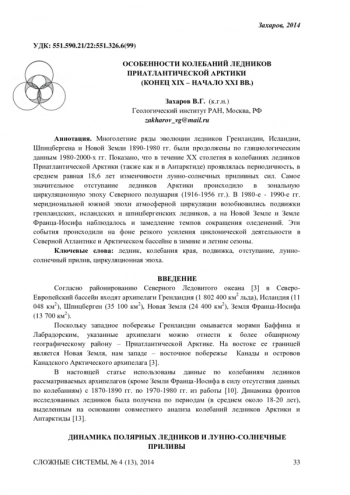Многолетние ряды эволюции ледников Гренландии, Исландии, Шпицбергена и Новой Земли 1890-1980 гг. были продолжены по гляциологическим данным 1980-2000-х гг. Показано, что в течение ХХ столетия в колебаниях ледников Приатлантической Арктики (также как и в Антарктиде) проявлялась периодичность, в среднем равная 18,6 лет изменчивости лунно-солнечных приливных сил. Самое значительное отступание ледников Арктики происходило в зональную циркуляционную эпоху Северного полушария (1916-1956 гг.). В 1980-е - 1990-е гг. меридиональной южной эпохи атмосферной циркуляции возобновились подвижки гренландских, исландских и шпицбергенских ледников, а на Новой Земле и Земле Франца-Иосифа наблюдалось и замедление темпов сокращения оледенений. Эти события происходили на фоне резкого усиления циклонической деятельности в Северной Атлантике и Арктическом бассейне в зимние и летние сезоны.
A long-term series of the evolution of glaciers in Greenland, Iceland, Spitsbergen and Novaya Zemlya in 1890-1980 were continued on glaciological data 1980-2000’s. It is shown that during the XX-th century in the fluctuations of glaciers Atlantic Arctic (just like in Antarctic) periodicity was manifested equal on the average of 18.6 years variability of luni-solar tidal forces. The most significant retreat of glaciers in the Arctic occurred during zonal circulation epoch of the Northern Hemisphere (1916-1956). In the 1980s - 1990s years of the meridional southern epoch of atmospheric circulation the surges of Greenland, Iceland and Spitsbergen glaciers were resumed, and on Novaya Zemlya and Zemlya Frantsa - Iosifa the slowdown in the rate of reduction of glaciations was observed. These events occurred against the background of a sharp increase in cyclonic activity in the North Atlantic and the Arctic basin during the winter and summer seasons.





